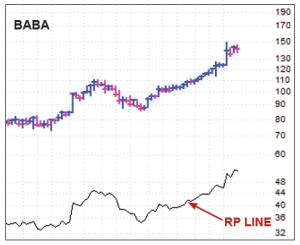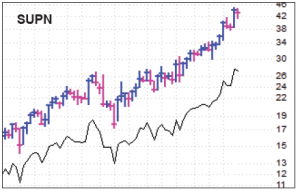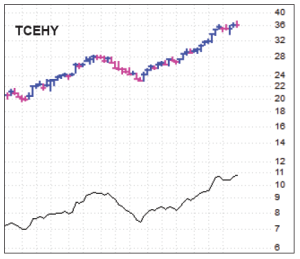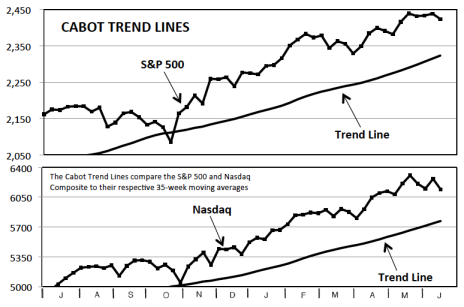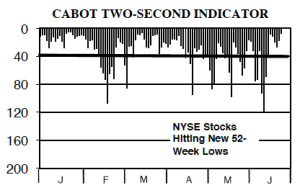In tonight’s issue, we write about what we’re seeing in the market’s recent rotation as well as another batch of studies that portend higher prices for the market down the road. We also dive into all our recommendations and present some of our favorite ideas for the next market upleg.
Cabot Growth Investor 1371
[premium_html_toc post_id="135901"]
More Cracks in the Wall
The media hyperventilates whenever the market has a bad day, but it’s usually best not to let short, sharp, scary declines worry you too much. In fact, those are just the types of declines that you often see in bull markets to shake out the weak hands before stocks march higher. Tops aren’t formed in a day or two.
Instead, most tops, even short- to intermediate-term tops, take time to form. That’s why it’s better to think of the market’s bullish trend as a wall—it’s highly unlikely to crack because of one bear attack, but a sustained onslaught by the sellers can be enough to bring it down and end the uptrend.
In our view, then, the mid-May one-day selloff (Nasdaq down 159 points) was no big deal; the market immediately snapped to new highs soon after. But the early June wave of distribution did some damage; we sold Netflix due to its abnormal action. And the big growth stock selloff last week has us worried—we’ve now seen multiple waves of selling, with more leading stocks (and the Nasdaq itself) dipping to support. More cracks in the wall!
That said, now’s not the time to throw in the towel. After a big run in recent months, the Nasdaq is about 4% off all-time highs, which is hardly a disaster, and our market timing indicators are still positive. Thus, we’re taking things on a stock-by-stock basis, both on the sell side (holding resilient stocks, selling those that break down) and buy side (looking for new leadership if the market finds its footing). We raised a bit more cash last week and we’re selling one more stock tonight.
And what about the rotation that’s going on, with money flowing into the energy, financial, transport and biotech sectors? We’re open to anything (and are hopeful biotech can provide a bunch of good opportunities going forward), but we want to make sure any stocks we consider still meet our criteria (great story, numbers and chart); otherwise the rallies can be cut short. Plus, we’re not so sure these newly strong areas will do well if the Nasdaq truly caves in.
All told, though, it’s still a bull market, and many studies point toward higher prices in the months ahead. Don’t forget that! But we’re also seeing more and more cracks in the bullish wall, so it’s best to pull back a bit and see how things play out—not just in terms of the market’s next move, but which stocks and sectors will be leading
the next upleg, whenever it occurs.
[highlight_box]WHAT TO DO NOW: Raise a bit more cash as the evidence has worsened, but be sure not to stick your head in the sand, either. In the Model Portfolio, we sold one-third of our remaining shares of Shopify last week, and tonight, we’re selling Tesla. That will leave us with 34% in cash. Details inside.[/highlight_box]
Model Portfolio Update
The mid-may and early-June selloffs didn’t have us overly worried, but now, when those are combined with the recent growth stock selloff, we’re seeing more and more ragged charts, as growth stocks come under distribution after nice advances. We took a few more shares of Shopify off the table last week, and tonight, we’re letting go of Tesla as our profit has shrunk.
That said, we’re not eager to turn outright defensive given the market’s stance. We’ll keep our Watch List up to date and be quick to add new stocks should the buyers return.
Current Recommendations
BUY—Alibaba (BABA 145)—BABA continues to do yeoman’s work, holding up as well as any institutional-quality growth stock as big investors appear hesitant to sell any of their positions. There’s more and more buzz surrounding the company’s recently launched Uni Marketing platform (including its Brand Databank, an online customer tracking dashboard), which leverages the browsing and buying data from Alibaba’s 454 million-plus active buyers across all of its e-commerce platforms to allow major brands to better segment, reach and retain their customers with tailored content and advertisements. Estimates for Uni Marketing are all over the place, but many expect it to be a huge, high-margin opportunity, and some big fish (like Publicis, an international ad firm with around $10 billion in annual revenue) are already signing up. We’d like to average up in BABA, because it has all the qualities of a long-lasting liquid leader. That said, with growth stocks under pressure, we’re not going to try to be a hero—we’ll stay on Buy, but new buyers should keep positions small given the environment.
HOLD—Facebook (FB 150)—FB has turned sloppy since early May, whipping back and forth between 145 and 156. Such volatility after a smooth advance tells you sellers are beginning to take a toll, which often marks a trend change. That said, like the Nasdaq itself, the stock is just a few percent off all-time highs and, fundamentally, a new, bullish data point seems to be released nearly every week, the most recent being that Facebook has surpassed two billion monthly active users (mind-boggling when you think about it), not to mention the pile of users for its other properties. We do wonder whether FB has become so popular so that it’s already reached its point of peak perception (no tree grows to the sky), and the stock’s relative performance (RP) line hasn’t made much progress since early 2016. Yet we still believe Facebook’s earnings can grow rapidly for many years to come, and the stock’s longer-term uptrend is clearly intact. It’s not strong enough for a Buy rating, but if you own some with a profit, we advise hanging on.
BUY—ProShares Ultra S&P 500 Fund (SSO 90)—On its own, SSO continues to act well enough, notching new highs in early June and remaining above its 50-day line despite some wobbles last week. And if the rotation into energy, financial and industrial stocks continue, this leveraged long fund could benefit as the S&P 500 takes the leadership baton from the Nasdaq. That said, there is a chance that the Nasdaq, if it cascades lower, will drag down everything in the days or weeks ahead. Thus, if you don’t own any, you could buy some here and use a tight stop in the 86 area. For our part, though, we’ve already taken half our shares off the table and with many studies pointing to higher prices down the road (written about later in this issue), we’re aiming to sit through any correction to capture greater longer-term gains.
SOLD ONE-THIRD, HOLD THE REST—Shopify (SHOP 88)—We decided to trim a few more shares from our Shopify position last week as the chart is turning iffy—the stock has moved below its 50-day line for the first time since December and has been stalling out since mid-May. We sold another one-third of our shares, which leaves us with just less than half of our original stake. (The profits from this sale and our prior partial sale total about 3% of the portfolio, with lots more profit still on the table.) Now the goal is to be patient and use a loose stop (the 30-week moving average, which is at 69 but advancing quickly, is one possibility) should the stock correct further. The company has been quiet on the news front, but we continue to see Shopify as a leader in the new theme of helping small- and mid-sized businesses make the most of their e-commerce opportunities, and think the stickiness of its business model (few clients will leave once they integrate Shopify’s systems) is underrated. If you have a good profit, you can take more profit off the table, but we advise holding onto the remainder and giving it plenty of room to maneuver.
SELL—Tesla (TSLA 327)—TSLA has come under pressure partly because of the market and partly because of a sub-par delivery report in Q2—the company delivered just over 22,000 vehicles in the second quarter, which was short of forecasts (although it was up 53% from Q2 of 2016) and caused a rash of cautious analyst commentary. Interestingly, production was much stronger (25,708 in the quarter) as bottlenecks involving 100kWH battery packs were solved in June. Looking ahead, deliveries of Model S and Model X automobiles should rise in the second half, and CEO Elon Musk said that production of the Model 3 should start soon, with production increasing to 1,500 Model 3s in September and 20,000 by December. But at the end of the day, big investors are having a hard time fully believing the estimates, as Tesla has generally missed its targets. More important, the stock cascaded today on the Q2 report, and while the chart isn’t a horror show, our profit is nearly gone (our average cost is around 325). Combined with the iffy environment for growth stocks, and we’re pulling the plug on TSLA in tonight’s issue, taking our small profit and will look for stronger situations once the market regains its footing.
HOLD—Universal Display (OLED 111)—We remember owning Intuitive Surgical many years ago; the stock often gapped higher on earnings, but proved hard to hold onto as it tended to chop sideways-to-lower in between quarterly reports. OLED has shown a similar pattern this year, with most of its gains coming after earnings, and lots of chop in the following weeks. Fundamentally, we think nothing has changed here (in fact, earnings estimates have been nudged up a bit in recent weeks, with 80% and 39% growth expected this year and next, respectively), but it’s not unusual for a highly valued (59 times this year’s earnings), down-the-food-chain stock to get hit when the market gets wobbly. Our average cost is just under 100, but given our prior decent profit, we don’t want to hold all the way down to our cost. Thus, we’re using a mental stop in the mid-100s area. Above that, the overall uptrend looks intact, but a decisive drop below would likely result in a deeper retreat.
HOLD—Veeva Systems (VEEV 61)—VEEV is another stock on a tight leash—shares have been able to hold north of its 50-day line during the June selling waves, which is good to see, but there’s no question the sellers have become more aggressive. Our game plan remains generally the same as it was two weeks ago. If VEEV can hold above the 57 to 58 area, we’re more than happy to sit tight, as the company has the combination of dependable growth and huge opportunity that big investors yearn for. However, a break of that support will likely result in a deeper consolidation and cause us to sell and protect the rest of our profit.
BUY—XPO Logistics (XPO 64)—XPO continues to act very well, with textbook breakout-and-follow-through action during the past month (all-time highs from both the stock and the RP line). There continue to be reports that CEO Bradley Jacobs could be lining up another big acquisition after 18 months on the sidelines, though odds favor any new buy adding to an existing business line and being accretive to cash flow in relatively short order. The renewed strength in transportation stocks (near the top of a two-plus-year consolidation) is also helping the cause. Pullbacks are certainly possible, especially if the growth stock weakness spills over into other areas, but with so much big-volume buying recently, the odds favor dips being supported by institutional investors. We’ll stay on Buy.
Watch List
Celgene (CELG 133): An emerging blue chip in the biotech space, CELG staged a huge-volume breakout two weeks ago and has held most of those gains since.
Exelixis (EXEL 25): EXEL is being driven by just one product, but it’s a great one that should earn an expanded indication soon.
PayPal (PYPL 55): PYPL has gyrated with the market, but is just a point or so off all-time highs and is early in its overall advance.
ServiceNow (NOW 105): NOW is also well above its early June low (even as the Nasdaq is below its early June nadir) and has great institutional sponsorship. A push back above 109 would be intriguing.
Zillow (Z 49): Z is one of the most impressive growth stocks we see out there today, with the story, numbers and chart (it soared to new highs in mid-June and has pulled back grudgingly since) to drive big gains over time.
Other Stocks of Interest
The stocks below may not be followed in Cabot Growth Investor on a regular basis. They’re intended to present you with ideas for additional investment beyond the Model Portfolio. For our current ratings on these stocks, see Updates on Other Stocks of Interest on the subscriber website or email mike@cabotwealth.com.
Carvana (CVNA 21) — While big used-car dealers like CarMax have a big online presence, customers eventually wind up at a traditional used-car lot. Not with Carvana! This company is taking the entire used-car buying experience online, with trade-ins, buying and financing all taking place online, sometimes in as little as 10 minutes. 360 degree photo technology lets shoppers inspect cars all around, and the company’s haggle-free pricing (and 150-point inspections) takes the stress out of buying. Carvana just opened its 31st location (Louisville, Kentucky) and has over 7,000 vehicles in inventory that can be delivered in a little as one day. Rapid expansion means no profits (yet), but revenue grew by 213% in 2015 and 180% in 2016. Used cars are a huge industry ($710 billion in annual sales) and Carvana is a powerful force for change.
Supernus Pharmaceuticals (SUPN 43) — Supernus is a drug company with a couple of reliable products on the market and excellent revenue and earnings growth. But two things have investors interested in this small (market cap is $2.2 billion) maker of treatments for epilepsy, migraines and seizures. The first is the company’s proprietary extended-release technology that makes its drugs more effective, giving a potential $500 million in peak revenue potential, compared with $215 million in sales in 2016. The second thing is the big one: the company’s candidate drug, SPN-812, is going into Phase III clinical trials as a treatment for ADHD in kids six to 12 years old. If the drug wins approval, management sees revenue potential of from $1.6 billion to $3 billion! And that prospect has investors getting their bets down.
Tencent Holdings (TCEHY 35) — China has fully embraced mobile technology, and Tencent Holdings has been riding that wave for years, attracting users with the most popular messaging and chat apps in China. Tencent boasts 938 million monthly active users (up 23% from a year ago) for its social apps and 861 million for its messaging app. Access to that kind of user base has enormous opportunities for monetization, which has boosted revenue by 28% in 2015, 40% in 2016 and 45% in Q1. The stock is up from 24 at the beginning of 2017 to 36 in recent trading, and has been active in buying stakes and forming alliances with other online giants. Tencent even took a 5% stake in Tesla in March. Stories don’t come much bigger than this.
Trivago (TRVG 22) — Netherlands-based Trivago is flexing its muscles in the online travel wars by keeping a tight focus on the hotel industry. Trivago monitors a ton of online hotel listings (including from online travel agencies, hotel chains and independent locations) and offers users a variety of filters to personalize their search results. Hotels pay to be listed and pay again when customers click through to their sites, a strategy that has pushed Trivago’s revenue up by 40% in 2015, 54% in 2016 and 58% in Q1. The company—which was just incorporated in 2016) has booked its first consecutive profitable quarters, and looks to be carving out a niche in the global online travel business.
Playing the Rotation Game
A Google search of “stock market rotation” brought us 762,000 results, so it’s a topic that’s clearly on investors’ minds. Since early June, we’ve seen selling in the hot growth stocks that have been leading for most of this year, with much of that money flowing into other areas, including energy stocks, financials and biotechs.
So should we sell our growth stocks and buy these newly strong areas? We might, but it’s important to stick with proven criteria and not just chase a hot chart. Energy stocks, for instance, have been declining in a straight line since mid-December before bouncing during the past two weeks—such a rebound could continue, but a bottom-building phase is likely over time. Financial stocks look much better, with the sector trying to emerge to new highs. Here, though, solid growth stories are relatively few and far between. We owned a couple of financials earlier in the year (to no avail), and we’re open to getting back into the group—but only if a stock with a real growth story emerges.
Biotech stocks are more intriguing to us, partly because of the group’s humongous decline-and-bottoming action since mid-2015, and partly because there’s a good mix of potential liquid leading stocks and glamour names that could attract a ton of buying.
Celgene (CELG) isn’t a new story, but the stock still has all the characteristics we look for in a liquid leader; analysts see earnings rising 20% to 25% annually for many years as new products launch and current drugs (treating multiple myeloma, breast cancer, psoriasis and more) increase market share. And the stock just exploded out of a long consolidation on enormous volume.
On the smaller side is Exelixis (EXEL), a firm with just one drug on the market (dubbed Cabometyx), which is selling extremely well as a treatment for renal cell carcinoma (kidney cancer). Sales of that product rose 68% in the first quarter and drove the firm’s bottom line into the black, and Exelixis will submit an expanded application for the drug this quarter. The stock had a big run through February, pulled back for a few months and is now showing signs of taking off again. Both CELG and EXEL are on our Watch List.
It pays to stay on top of where the money is flowing in the market, but it’s also important not to make dramatic moves to chase recent performance. Biotech stocks have the most promise of the newly strong groups, but we’re open to anything as long as it possesses the story, numbers and chart that would support a sustained upmove.
Calm, Positive First Half Bodes Well
The market’s near-term outlook is up in the air, but, in the background, we continue to see more evidence that the bull market has further to run. The most recent evidence involves the market’s relatively calm, smooth advance over the first six months, which usually leads to good things in the back half of the year.
First is a study that shows how the market performed historically after a positive first six months. Amazingly, it turns out that, during the past 50 years, if you bought the S&P 500 at the start of July after the first half was positive, you would have made a total of 410%. But if you bought after a down first half, you’d have lost a total of 17%!
The second study looks at what happened when the first half of the year was up at least 8% (as it was this year). Since 1950, the S&P has been up 8% in the first half 25 times, and in 84% of those years, further gains occurred in the second half, with an average gain of 7.1%.
Third (and most interesting to us) is a study that examines the market’s amazing steadiness during the first half of 2017—the maximum pullback in the S&P 500 during the first six months was less than 3%, which, historically, is very small. However, it’s also rather bullish! Since 1928, there have been just 16 years when the maximum first half pullback was less than 5%. On average, those 16 years saw a second half gain of 7.8%, which was double the average second half gain of all years.
Lastly, of course, is our own 7.5% Rule, which flashed in February and portends solid gains in the months ahead, as well as our Cabot Trend Lines, which remain on their Buy signal from April 2016.
None of this means we won’t raise more cash should growth stocks break down in the near term. But it’ll probably pay not to get overly bearish, as numerous indicators and studies tell us higher prices are likely down the road.
Cabot Market Timing Indicators
Some macro (Two-Second Indicator) and micro factors (hiccups among growth stocks) are reasons for a little caution, but the market’s major trends are still up, few leading growth stocks have broken down and some are even pushing to new highs. In all, the evidence remains mostly bullish, so we do, too.
Cabot Trend Lines: Bullish
Despite some hesitation and retrenchment during the past month, our Cabot Trend Lines remain clearly bullish, as both the S&P 500 (by 4.3%) and Nasdaq (by 6.4%) closed well above their respective 35-week moving averages. While the market’s short-term outlook is a bit up in the air, the longer-term trend is firmly up, and thus we expect this bull market to result in higher prices in the months ahead.
Cabot Tides: Bullish
Our Cabot Tides remain bullish, but also remain as divergent as ever—after months of lagging, the S&P 600 SmallCap (shown here), for instance, is above its 50-day line and close to new highs, while the Nasdaq has dipped below its support level and is acting sick. Overall, the intermediate-term trend for the market as a whole is positive, though it’s clear crosscurrents remain intense; it’s more of a stock picker’s market than a blanket advance.
Two-Second Indicator: Healthy
Thanks to a rotation out of a narrow set of growth stocks and into many other areas of the broad market, we’ve seen enough improvement in the number of new lows (eight straight trading days of fewer than 40 new lows) for our Two-Second Indicator to turn positive. Of course, the indicator has been on-again, off-again in recent months, but going with what we see today, the broad market has turned healthy, which should provide some new opportunities going forward.
[premium_html_footer]
Send questions or comments to mike@cabotwealth.com.
Cabot Growth Investor • 176 North Street, Post Office Box 2049, Salem, MA 01970 • www.cabotwealth.com
All Cabot Growth Investor’s buy and sell recommendations are made in issues or updates and posted on the Cabot subscribers’ website. Sell recommendations may also be sent to subscribers as special bulletins via email and the recorded telephone hotline. To calculate the performance of the portfolio, Cabot “buys” and “sells” at the midpoint of the high and low prices of the stock on the day following the recommendation. Cabot’s policy is to sell any stock that shows a loss of 20% in a bull market (15% in a bear market) from our original buy price, calculated using the current closing (not intra-day) price. Subscribers should apply loss limits based on their own personal purchase prices.
Charts show both the stock’s recent trading history and its relative performance (RP) line, which shows you how the stock is performing relative to the S&P 500, a broad-based index. In the ideal case, the stock and its RP line advance in unison. Both tools are key in determining whether to hold or sell.
THE NEXT CABOT GROWTH INVESTOR WILL BE PUBLISHED JULY 19, 2017
We appreciate your feedback on this issue. Follow the link below to complete our subscriber satisfaction survey: Go to: www.surveymonkey.com/marketlettersurvey
Neither Cabot Wealth Network nor our employees are compensated by the companies we recommend. Sources of information are believed to be reliable, but are in no way guaranteed to be complete or without error. Recommendations, opinions or suggestions are given with the understanding that subscribers acting on the information assume all risks. © Cabot Wealth Network. Copying and/or electronic transmission of this report is a violation of U.S. copyright law. For the protection of our subscribers, if copyright laws are violated, the subscription will be terminated. To subscribe or for information on our privacy policy, call 978-745-5532, visit www.cabotwealth.com or write to support@cabotwealth.com.
[/premium_html_footer]


